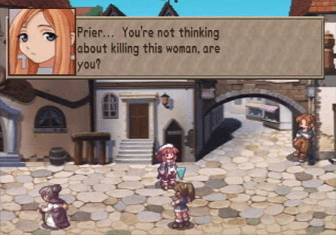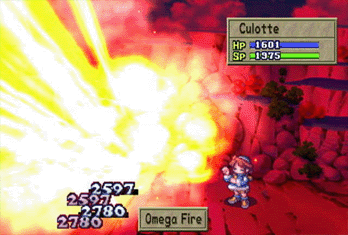Strategy RPGs piss me off. It takes 20 minutes to do even a simple battle, you get virtually no exploration, you don’t get to strengthen or balance your party but you DO have to micromanage everything but their bathroom habits (praise the Lord), they have learning curves that defy geometry, and not only is this acceptable, it’s also purely addicting. I wonder why we don’t see thetruth.com ads attack Yasumi Matsuno. Final Fantasy Tactics killed me. Great game, great plot, but I lost years trying to beat that game. I couldn’t look at another strat ever again.
Then came Christmas 2004 (or, as I call it, the Winter of Miscontent), and I had about five minutes to use up an EB Gift card or lose $30. The only thing I could find that struck my interest was a used LA PUCELLE TACTICS, which I didn’t recognize, given that DISGAEA was currently ruling the tactical RPG roost. So I bought it with some reluctance, made fun of the cashier because he was fat, dashed out of the mall, and caught a bus that took me to the border—apparently that cashier was running a cartel and made a few phone calls—where I leased out my body cavities to that very same cartel so I could get home. Eighteen months later I made it home, hobbled over to a working PlayStation 2 and started up the game that just about got me scarfaced.
Was it worth it?
Hell yes.
La Pucelle Tactics not only corrects a lot of what I found broken with the Shining Forces and such, but it nails every bit of its own content. It’s purely charming with a lot of depth and room to customize your characters without feeling totally baseless. It’s not a perfect game, but man I gotta wonder who could possibly resist having fun playing it.
The first thing you need to know (and it’s almost kind of a warning) is that this is a top contender for CUTEST TACTICAL RPG EVER MADE. If you have diabetes, you better get a wheelchair, because this game is just about that sweet and sugary. Not a trace of masculinity can be found in the mostly female-and-French-pastry anime architecture. All of the basic design—graphics, background design, soundtrack—is colorful and soft and light-hearted and bouncy, and you’ll be tasting raspberries and Cool Whip by the time you get started. If you can get past that, you’ll be OK.
La Pucelle Tactics’ major strength seems to be a very outgoing sense of developmental commitment. Almost everything about this game is well-crafted or, at the very worst, competent enough to get by. The graphics are very well drawn and animated, the battle system runs smoothly with minimal fuss, and the soundtrack fits the overall style of the game nicely (and even surprises on a few occasions). The characters are easily the most endearing and memorable factor, and I don’t know if it’s the fact that the main girl (Prier) is one cup size short of busting out of her habit, or that her 12-year-old brother (Culotte) is named after panties, wears a dress, and throws lollipops in battle, but the decent-sized cast is wonderfully well-balanced and creatively designed. Not one character is overly clichéd and not one drags their feet in battle. Instead, they come to life with bizarre quirks, awesome attacks, and well-suited dialogue and actions, and dammit, they’re just really likable and memorable.
It’s a really good thing the characters are well-balanced, because you’ll need balance on the battlefield. Fighting in La Pucelle can be complicated, but it’s a lot more user-friendly than a lot of other strats out there. You start out at a special tile on the battle map, and from there you get to choose your combatants. You can choose up to eight people, but you don’t have to have them all out in one shot. You can start out with two if you want, and when your next round comes up, you can add more people in or substitute them, but you can’t add up more than eight people in a battle. If seven fighters die, you can only put one more on the battlefield or run.
Once your people are in place, you can have several of them gang up on one enemy and have them all attack at the same time (with experience points divided up) by putting in the proper commands and waiting for your “attack” turn. Or, you can have characters attack in singles with special commands that operate automatically (as in, you don’t need to wait for an attack turn). Your enemies get to do likewise and they’re not stupid, so watch yourself. You get LARGE battle maps to move about in, and throughout the maps are little energy portals where enemies regenerate. These energy portals produce dark energy “currents,” which you can manipulate in your favor to really even the odds in the form of “miracle attacks.” The big thing about battle is that you can capture your enemies and add them to your ranks. You don’t get loads and loads to choose from and they’re not as good as the regular characters, but this is absolutely essential for getting through the game.
One of the downsides of this game is that it cannot escape the curse of strat-RPG micromanagement. There’s a LOT of stuff you have to do to keep yourself afloat. First, you have to equip your fighters, and this game is unique in that because there aren’t weapon and armor slots; there are just four slots which you can fill up totally at your discretion. You can have a character equipped with the same four swords if you want, but you really don’t want that. Every item you equip strengthens some combination of your attributes in an experience system of its own, which will obviously increase but also give you special battle bonuses (100% hit, MEGA damage, etc). You can also strengthen the items themselves by having characters who can “purify” clean up the board of dark portals, but that can take more time than it’s worth. The least fun thing to strengthen is the magic and special abilities because, again, it can take up more time than it’s worth.
Back to positive aspects. You get a LOT of stuff to do in this game—if you were stranded on a desert island for six months, this game could easily satisfy the hours you spend between surviving on coconuts and converting your beard into toilet paper. The main game is 60-70 hours, but the sidequests and additional challenges you can face quadruple those hours, and there’s little chance of going through the main quest the same way twice. Given all that you get to do, the game itself it surprisingly streamlined, meaning you can get to all the places and stuff you want to do with little fuss. There is rarely much to do in the city areas (there’s not even a reason to have more than one shop in the whole game) but the developers wisely chose to put everything you really need to do in this game on the battlefield instead of making you run around talking to people.
While I doubt this game is good enough to turn doubters into believers (Final Fantasy IV already took that spot and doesn’t look ready to leave), you’ll be a born-again strategist just a few chapters into the game. This game is awesome and worth losing every fabric of your sexuality in Mexico.
In closing this review, I have provided you a copy of the Anglo-Catholic Ave Maria (Hail Mary) to say every time you run off to DeviantArt and fap to images of a 16-year-old nun so that you’ll be square with God.
“Hail Mary, full of grace, our Lord is with you; Blessed are you among women and blessed is the fruit of your womb, Jesus; Son of Mary, Son of the living God, have mercy upon us, now, and at the hour of our death. Amen.”


